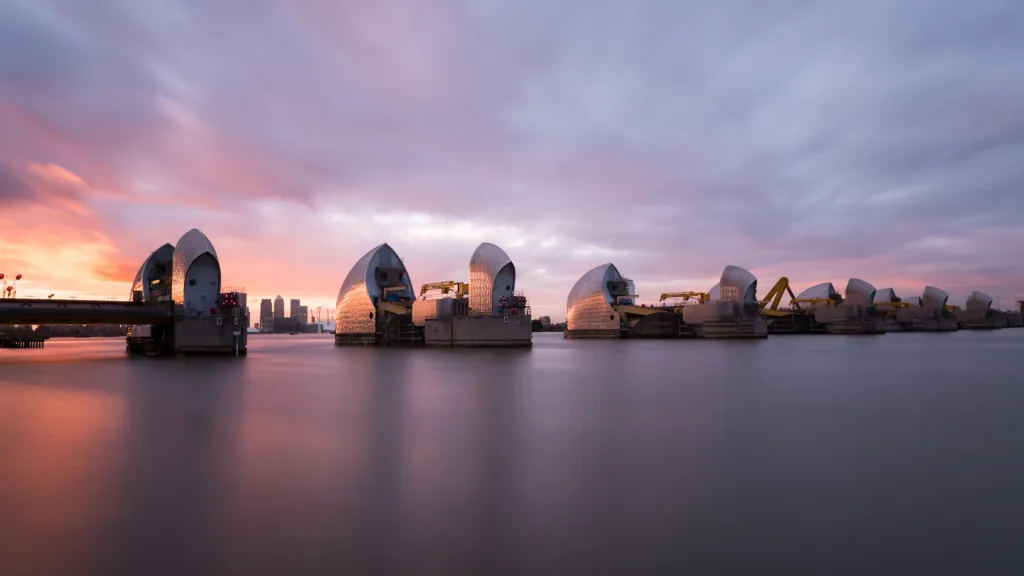The Thames Barrier in London
Discover the construction techniques that architects around the world use to create buildings resistant to natural disasters. Learn about three successful cases that have made a difference in protecting communities.
Construction that withstands natural disasters has become a priority for architects and engineers aiming to protect communities and minimize material loss. In areas vulnerable to phenomena such as earthquakes, hurricanes, and floods, advanced techniques and special materials have been developed to increase building safety. Below, we will explore three successful cases worldwide that show how construction techniques can make a crucial difference in the face of natural disasters.
Innovation in earthquake-resistant construction: Japan’s case
Japan, a country located in the Pacific Ring of Fire, is highly vulnerable to earthquakes. Given this situation, Japanese architects have adopted advanced construction technologies that allow buildings to be flexible and resilient. One of these techniques is the use of seismic dampers, which absorb earthquake energy and reduce the impact on structures. Base isolation systems that decouple the building from ground movement have also been implemented.

Tokyo Skytree
A prominent example is the Tokyo Skytree, a 634-meter tall broadcasting and observation tower. The architects behind this project used a damping system inspired by Japanese pagodas, which are designed to withstand tremors thanks to their flexible core. This structure incorporates a vibration absorption system that minimizes seismic impact, allowing the tower to remain stable even during strong earthquakes. The effectiveness of these techniques has been demonstrated in recent tremors, making Japan a global leader in earthquake-resistant construction.
Flood Defense: The Thames Barrier in London
London has implemented construction solutions to defend against floods caused by rising sea levels and river activity. The construction of the Thames Barrier, one of the largest flood protection infrastructures in the world, represents a true feat of modern engineering. This system of movable barriers controls the flow of water in the Thames and prevents it from reaching populated areas during storms or high tides.
The barrier, completed in 1982, has proven its effectiveness by being activated more than 200 times, protecting millions of people and London’s infrastructure. This project has inspired other cities seeking innovative construction solutions to face floods. The architects and engineers who worked on this structure equipped it with a modular design and a gate system that allows quick activation, setting a benchmark in disaster protection.
Architects and sustainable construction: hurricane protection in Puerto Rico
Puerto Rico has been hit several times by devastating hurricanes, such as Hurricane Maria in 2017. After this tragedy, architects and engineers on the island adopted more resilient construction techniques and materials for hurricanes. Many buildings on the island are now constructed with reinforced concrete, a material that offers greater resistance to wind and heavy rains, and windows and roofs resistant to impact are also installed.
A standout case is the Casa Resiliente in the Caño Martín Peña community in San Juan. This home is designed to withstand hurricane winds of up to 250 km/h and allows families to shelter during storms. The construction incorporates elevation techniques to prevent flood damage, as the house is raised on stilts, protecting its inhabitants from rising waters. This design has been replicated in other vulnerable areas, showing that resilient architecture is achievable even in low-resource regions.
Fernando Abruña, FAIA.
Conclusion
Architecture and construction techniques have evolved to offer greater safety against natural disasters. From seismic dampers in Japan to elevated structures against hurricanes in Puerto Rico, these advancements demonstrate the positive impact of construction innovation. Thanks to these successful projects, architects continue developing solutions that protect lives and entire communities, contributing to a safer and more sustainable future.

